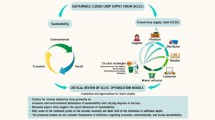Abstract
This paper is concerned with integrated production, inventory and transportation planning problems directly related to the supply chain management. We establish a Lagrangian based coordination mechanism within the context of the decentralized planning approach. In addition, we demonstrate that dual prices obtained by the described approach might provide enough accuracy in case of sudden changes, such as in a customer’s demand, and thus they could assist agents to find new solutions. Computational results show that the proposed mechanism is able to help organizations to facilitate collaboration, improve business agility and meet business goals.













Similar content being viewed by others
References
Ahuja KR, Magnati TL, Orlin JB (1993) Network flow: theory, algorithms and applications. Prentice Hall, New Jersey
Barbarosoglu G, Özgür D (1999) Hierarchical design of an integrated production and 2-enchelon distribution system. Eur J Oper Res 118:464–484
Bazaraa MS, Shetty CM (1979) Nonlinear programming—theory and algorithms. Wiley, New York
Bertsekas DP (1991) Linear network optimization. MIT Press, Massachusetts
Burton RM, Obel B (eds) (1995) Design models for hierarchical organizations: computation, information and decentralization. Kluwer Academic Publishers, Boston
Cachon GP, Fischer M (2000) Supply chain inventory management and the value of shared information. Manag Sci 46:1032–1048
Chen F, Federgruen A, Zheng YS (2001) Coordination mechanisms for a distribution system with one supplier and multiple retailers. Manag Sci 47:691–708
Eksioglu B, Migdalas A, Pardalos PM (2003) Heuristic approaches to production distribution problems in supply chain. In: Pardalos PM, Korotkich V (eds) Optimization and industry: new frontiers. Kluwer, Dordrecht, pp 15–37
Erenguc SS, Simpson NC, Vakharia AJ (1999) Integrated production/distribution planning in supply chains. Eur J Oper R 115:219–236
Ertogal K, Wu SD (2000) Auction-theoretic coordination of production planning in the supply chain. IIE Trans 32:931–940
Fudenberg D, Levine DK (1999) The theory of learning in games. MIT Press, Cambridge
Grigoriadis MD (1986) An efficient implementation of the network simplex method. MathProgram Study 26:83–111
Guignard M, Kim S (1987) Lagrangean decomposition: a model yielding stronger Lagrangean bounds. Math Program 39:215–228
Jennings NR, Sycara K, Woodridge M (1999) A roadmap of agent research and development. Auton Agent Multi Agent Syst 1:7–38
Johnson LA, Montgomery DC (1974) Operations research in production planning, scheduling, and inventory control. Wiley, New York
Jörnsten K, Migdalas A (1988) Designing a minimum spanning tree network subject to a budget constraint. Optimization 19:475–484
Jörnsten K, Näsberg M (1986) A new Lagrangian approach to the generalized assignment problem. Eur J Oper Res 27:313–323
Jörnsten K, Nasberg M, Smeds P (1985) Variable splitting—a new Lagrangean relaxation to some mathematical programming models. Report LiTH-MAT-R-85-04, Linkoping Institute of Technology, Sweden
Kuhn HW (ed) (1997) Classics in game theory. Princeton University Press, Princeton
Larsson T, Migdalas A, Ronnqvist M (1994) A Lagrangean heuristic for the capacitated concave minimum cost network flow problem. Eur J Oper Res 78:116–129
Lou P, Zhou ZD, Chen YP, Wu A (2004) Study on the multiagent based agile supply chain management. Int J Adv Manuf Tech 23:197–203
Martin CH, Dent DC, Eckhart JC (1993) Integrated production, distribution and inventory planning at Libbey–Owens–Ford. Interfaces 23:68–78
Robinson J (1951) An iterative method of solving a game. Ann Math 54:296–301. [Reprinted in Kuhn HW (ed) (1997) Classics in game theory. Princeton University Press, Princeton, pp 27–35]
Sadeh NM, Hildum DW, Kjenstad D, Tseng A (2001) MASCOT: an agent-based architecture for dynamic supply chain creation and coordination in the Internet economy. Prod Plan Control 12:212–223
Shapiro JF (1979) Mathematical programming—structures and algorithms. Wiley, New York
Shor NZ (1985) Minimization methods for non-differential functions. Springer, Berlin
Thomas DJ, Griffin PM (1996) Coordinated supply chain management. Eur J Oper Res 94:1–15
Thonemann UW (2002) Improving supply-chain performance by sharing advance demand information. Eur J Oper Res 142:81–107
Woolbridge M (2002) An introduction to multi-agent systems. Wiley, New York
Author information
Authors and Affiliations
Corresponding author
Appendix
Appendix
We consider the linear program
and rewrite it in the equivalent form
We will assume that X and Y are polytopes, i.e., closed and bounded polyhedra. Applying Lagrangian relaxation to the equality constraints, the problem separates into two Lagrangian subproblems:
and
The Lagrangian dual problem is then \( {\max _{\mathbf{v}} \min _{({\mathbf{x}},{\mathbf{z}},{\mathbf{y}})} L({\mathbf{x}},{\mathbf{z}},{\mathbf{y}},{\mathbf{v}})}, \) where \( {L({\mathbf{x}},{\mathbf{z}},{\mathbf{y}},{\mathbf{v}}) = {\text{val}}_1 ({\mathbf{v}}) + {\mathbf{val}}_2 ({\mathbf{v}})}. \) Suppose we solve it using the simple sub-gradient algorithm, that is, by creating a sequence \( {\{ {\mathbf{v}}(k)\} ,} \) where \( {{\mathbf{v}}(k + 1) = {\mathbf{v}}(k) + \alpha (k){\mathbf{g}}(k)}, \) \( {k \ge 1 ,\,{\mathbf{g}}(k) = {\mathbf{z}}(k) + {\mathbf{y}}(k)} \) with (x(k), z(k)) and y(k) being the subproblem solutions, and α(k) ≥ 0 satisfying α(k) → 0 and \( \sum\nolimits_{k = 1}^\infty {\alpha (k) = \infty } . \) Then \( {\{ {\mathbf{v}}(k)\} \to {\mathbf{v}}^* }, \) where v * is an optimal dual solution.
Next we introduce the weights
and define the weighted sequence, \( {\{ {\mathbf{x}} (N ) ,{\mathbf{z}} (N ) ,{\mathbf{y}} (N )\} ,} \) where
Clearly, by the convexity of X and Y and since, \( {\sum\nolimits_{k = 1}^N {\beta (N;k)} = 1},\,\beta (N;k) \ge 0{\;\{ {\mathbf{x}}({N})\} \in {X}},\,\{ {\mathbf{z}} ({N})\} \in Y \) and \( \left\{ {{\mathbf{y}} ({N})} \right\} \in Y. \) Hence, {x(N) z(N) y(N)} has an accumulation point \( ({\hat{\mathbf{x}}},{\hat{\mathbf{z}}},{\hat{\mathbf{y}}}) \) X × Y × Y. Moreover, let g(N) be the subgradient at \( {\{ {\mathbf{x}} ({N}),{\mathbf{z}} (N),{\mathbf{y}} ({N})\} }, \) then \( {{\mathbf{g}} (N )= \sum\limits_{k = 1}^N {\beta (N;k)} ({\mathbf{z}}(k) - {\mathbf{y}}(k))} \) by the definition of \( {\{ {\mathbf{x}} ({N}),{\mathbf{z}} ({N}),{\mathbf{y}} ({N})\} .} \) Then, since, \( {{\mathbf{v}}(k + 1) = {\mathbf{v}}(k) + \alpha (k){\mathbf{g}}(k),\,\;k \ge 1}, \) we have \( {\sum\nolimits_{k = 1}^N {\beta (N;k)} {\kern 1pt} {\mathbf{g}}(k) = \frac{{{\mathbf{v}}(k + 1) - {\mathbf{v}}(1)}}{{\sum\nolimits_{i = 1}^N {\alpha (i)} }}} \) which approaches 0 since \( \left\{ {{\mathbf{v}}(k)} \right\} \to {\mathbf{v}}^* \) as \( k \to \infty \) and \( {\sum\nolimits_{i = 1}^N {\alpha (i)} \to \infty } \) as N → ∞. Thus, \( {\{ {\mathbf{g}}(N)\} \to 0} \) and consequently the accumulation point of the sequence \( {\{ {\mathbf{x}}(N),{\mathbf{z}}(N),{\mathbf{y}}(N)\} } \) solves P2 implying that \( ({\hat{\mathbf{x}}},{\hat{\mathbf{y}}}) \) solves P1. This proves Proposition 2.
Rights and permissions
About this article
Cite this article
Karakitsiou, A., Migdalas, A. A decentralized coordination mechanism for integrated production–transportation–inventory problem in the supply chain using Lagrangian relaxation. Oper Res Int J 8, 257–278 (2008). https://doi.org/10.1007/s12351-008-0016-4
Received:
Revised:
Accepted:
Published:
Issue Date:
DOI: https://doi.org/10.1007/s12351-008-0016-4




